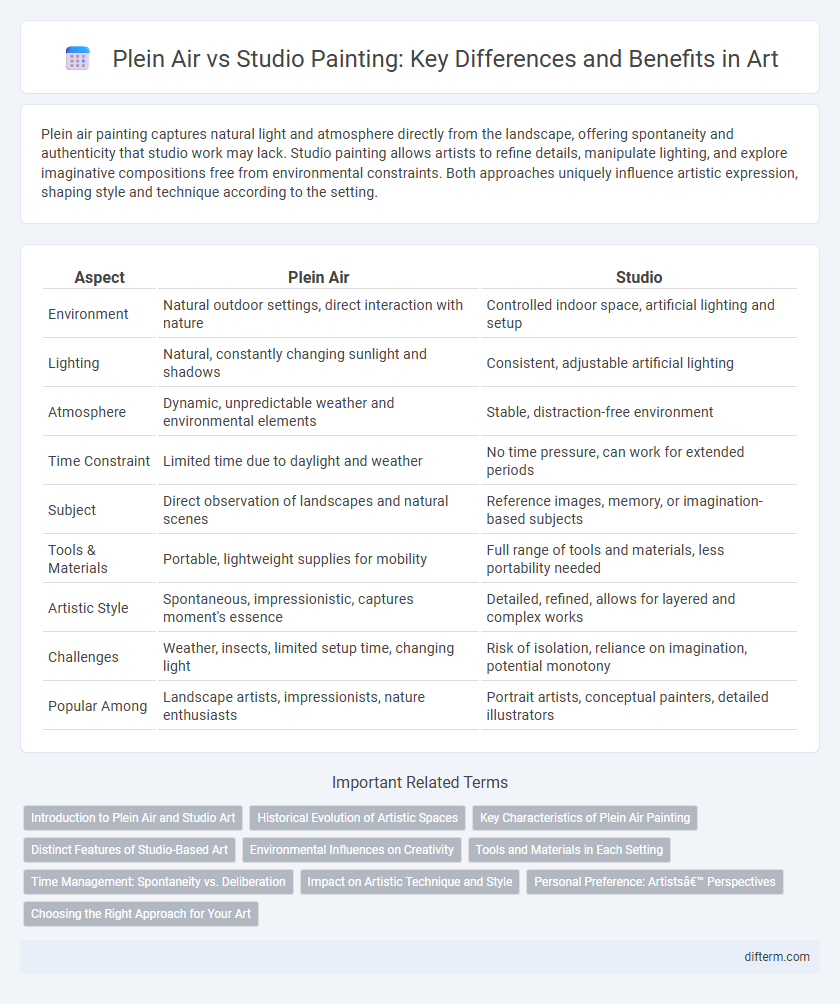Plein air painting captures natural light and atmosphere directly from the landscape, offering spontaneity and authenticity that studio work may lack. Studio painting allows artists to refine details, manipulate lighting, and explore imaginative compositions free from environmental constraints. Both approaches uniquely influence artistic expression, shaping style and technique according to the setting.
Table of Comparison
| Aspect | Plein Air | Studio |
|---|---|---|
| Environment | Natural outdoor settings, direct interaction with nature | Controlled indoor space, artificial lighting and setup |
| Lighting | Natural, constantly changing sunlight and shadows | Consistent, adjustable artificial lighting |
| Atmosphere | Dynamic, unpredictable weather and environmental elements | Stable, distraction-free environment |
| Time Constraint | Limited time due to daylight and weather | No time pressure, can work for extended periods |
| Subject | Direct observation of landscapes and natural scenes | Reference images, memory, or imagination-based subjects |
| Tools & Materials | Portable, lightweight supplies for mobility | Full range of tools and materials, less portability needed |
| Artistic Style | Spontaneous, impressionistic, captures moment's essence | Detailed, refined, allows for layered and complex works |
| Challenges | Weather, insects, limited setup time, changing light | Risk of isolation, reliance on imagination, potential monotony |
| Popular Among | Landscape artists, impressionists, nature enthusiasts | Portrait artists, conceptual painters, detailed illustrators |
Introduction to Plein Air and Studio Art
Plein air painting involves creating artwork outdoors, capturing natural light, atmosphere, and landscapes directly from the environment. Studio art typically takes place indoors, allowing artists to work with controlled lighting, detailed compositions, and a broader range of mediums. Both approaches offer unique advantages: plein air emphasizes spontaneity and true-to-life color, while studio art provides space for refinement and experimentation.
Historical Evolution of Artistic Spaces
Plein air painting emerged prominently during the 19th century with the Impressionist movement, emphasizing natural light and outdoor environments to capture transient effects. Studio spaces, traditionally enclosed and controlled, allowed artists greater manipulation of composition and lighting but often disconnected works from immediate reality. The historical evolution shows a dynamic interplay where plein air techniques challenged studio conventions, expanding artistic expression and influencing modern art practices.
Key Characteristics of Plein Air Painting
Plein air painting emphasizes capturing natural light, color, and atmosphere by working outdoors directly within the environment. Artists prioritize spontaneity, quick brushstrokes, and sensory interaction with the landscape to reflect transient weather and lighting conditions. This technique fosters a vibrant, dynamic representation that contrasts with the controlled, detailed environment of studio painting.
Distinct Features of Studio-Based Art
Studio-based art offers precise control over lighting, composition, and materials, allowing artists to meticulously refine details and experiment with complex techniques. The environment fosters uninterrupted focus, enabling prolonged work sessions essential for layered textures and intricate brushwork. This controlled setting supports diverse media use and facilitates reproducibility, distinguishing it sharply from the spontaneous and variable conditions of plein air painting.
Environmental Influences on Creativity
Plein air painting immerses artists directly in natural settings, allowing evolving light, weather, and landscapes to dynamically shape creative expression and color choices. Studio environments provide controlled conditions where artists can manipulate materials and revisit scenes without environmental interruptions, fostering focused refinement and imaginative variations. Environmental influences in plein air work often lead to spontaneous, vibrant compositions, while studio art reflects deliberate, detailed interpretations shaped by the artist's internal vision.
Tools and Materials in Each Setting
Plein air painting requires portable, lightweight tools such as travel easels, compact palettes, and fast-drying acrylics or watercolors, enabling artists to adapt quickly to changing natural light and weather conditions. Studio work allows for a broader range of materials including large canvases, oil paints with slow drying times, and extensive brush collections, offering greater control and detail. The choice of tools and materials directly influences the techniques and outcomes unique to each artistic environment.
Time Management: Spontaneity vs. Deliberation
Plein air painting demands rapid execution to capture transient natural light and atmospheric conditions, emphasizing spontaneity and immediate creative response. Studio work allows for deliberate time management, enabling artists to refine details, adjust compositions, and revisit pieces without the constraints of changing environmental factors. Balancing these approaches helps artists develop both intuitive skill and meticulous craftsmanship in their practice.
Impact on Artistic Technique and Style
Plein air painting fosters spontaneous brushwork and dynamic color variations, capturing natural light and atmospheric nuances that enhance realism and vibrancy. Studio work allows for meticulous detail and controlled composition, encouraging refinement of technique and exploration of complex themes. The choice between plein air and studio profoundly shapes an artist's style, with outdoor painting driving expressive immediacy and studio settings promoting polished precision.
Personal Preference: Artists’ Perspectives
Artists often choose between plein air and studio painting based on personal preference, valuing the direct engagement with natural light and changing landscapes in plein air settings. Studio work offers controlled environments that enable meticulous detail and extended compositional development without weather interruptions. Preferences hinge on individual creative processes and desired interaction with the subject, influencing technique and emotional expression.
Choosing the Right Approach for Your Art
Selecting between plein air and studio painting depends on your artistic goals and environmental preferences. Plein air painting offers dynamic natural light and atmosphere, enhancing color accuracy and spontaneity, while studio work allows controlled conditions for detailed compositions and experimentation with mediums. Understanding the needs of your subject matter and personal workflow will help determine the most effective approach for your art.
plein air vs studio Infographic

 difterm.com
difterm.com